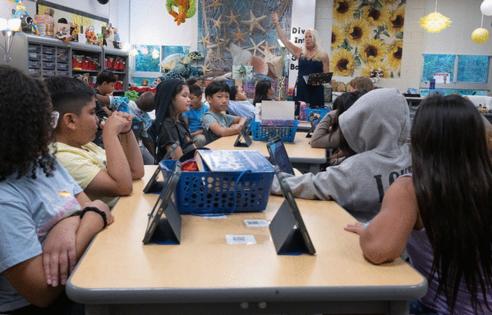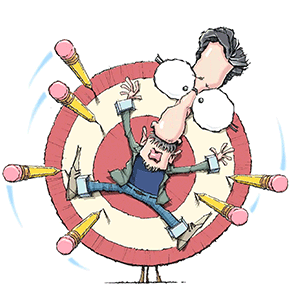Minnesota schools put limits on students using cellphones. Tablets might be next
Published in News & Features
ST. PAUL, Minn. — The assignment for Kathryn Perrotta’s fourth-graders: Learn about density by building a “neutral buoyancy” contraption that wouldn’t sink or float.
The St. Paul summer school students turned to their iPads and an app where they had drafted plans the day before. Then they ditched the screens for a bin full of materials, including balloons, straws, marbles and popsicle sticks, and worked with their peers to bring their drawn-out plans to life.
That practice — look online to learn, then reinforce a lesson with hands-on, off-screen activities — is intentional, and one Perrotta comes back to with most of her lessons at Frost Lake Elementary.
“I want parents to know that screen time in the classroom is not passive,” Perrotta said. “It’s something that is purposeful, closely monitored and balanced.”
The COVID-19 pandemic forced educators and families to embrace technology in learning, and most Minnesota school districts provide a tablet or laptop for each child. Now, amid broader cultural concerns about screen time and its impact on kids’ attention spans and mental health, parents and teachers are asking more questions about moderation when it comes to in-class devices, especially for younger students.
Schools statewide have already had to reckon with cellphones, after the Legislature in 2024 required districts to develop policies about if and how students could use phones in class. The next push, education leaders say, could be for additional guidance or structure on how — or how long — devices are used in class.
“I feel like during COVID, everyone just kind of said, ‘Go for it,’ when it came to tech in education,” said Marguerite Ohrtman, the director of school counseling at the University of Minnesota. “We didn’t know what that impact was, and now we have people going, ‘Oh wait, is this addictive? Is there long-term harm?’ ”
In 2022, a state law went into effect banning students in publicly funded preschools and kindergartens from using a device meant for individual use (like an iPad or smartphone) without “engagement from a teacher or other students.”
That still leaves ambiguity about the amount of time students, especially those older than kindergarten, should spend on screens in class.
John Horton, a teacher at J.J. Hill Montessori in St. Paul, makes it a priority to discuss responsible technology use with his students and their parents. His second-grade students are limited to 25 minutes of classroom screen time a day, and older grades can have longer if they are using their iPad for research.
Most students know the routine, but some still have a hard time handing the device over, he said.
“We talk about how some technology is designed to pull your attention,” Horton said, adding that he prompts his students to think about whether the time on their device is helping them learn.
“There’s definitely a place for technology in the classroom,” he said. ”But it has to be carefully taught and mindfully curated, and I’m not sure we are always doing a great job of that yet."
Parent Katlynn Moorehead said technology use in the classroom will factor into where she chooses to send her 5-year-old son to kindergarten. She has a background in child development and worries about the websites and apps designed to capture children’s attention.
That’s why she’s considering a private school that doesn’t provide students with devices until middle school.
“I think we are all just doing the best with what we have and trying to raise our kids to be safe, healthy and happy,” she said.
Communicating to parents about screens in the classroom is, ironically, made easier by online learning platforms, said Phil Boyd, a kindergarten teacher at R.L. Stevenson Elementary in Fridley.
Before the year starts, Boyd said he explains to parents his philosophy on tech in the classroom: He uses it when it enhances learning and only in small groups that rotate through activities. An individual student likely gets just 20 minutes on a computer once or twice a week.
Teachers design lessons around learning goals, which sometimes include helping students develop technological skills, Boyd said.
“We don’t just decide to use technology because it’s easy,” he said. “We decide to use these tools because they’re important.”
Shannon Skibba, a second-grade teacher in the Fridley district, also includes technology in rotations, which offers variety and allows her to monitor the students on screens. She’s noticed that students are usually more excited for the hands-on activities than the ones on a device, though it depends on the kid and how much screen time they get at home.
“Most of the feedback they give me is they actually want that balance,” she said. “But they do ask for more video games.”
In Perrotta’s summer school classroom in St. Paul, students’ iPad screens went dark on their desks as they worked to craft their science projects with marbles, twine and plastic foam.
Student Merida Auld said she enjoyed designing her idea on the iPad, which she sees as “helpful for learning.”
“But we are good at making sure not to do too much on it so we don’t get addicted,” she said. “We always talk about that in class.”
Classmate Eh Ku Wah said she loves taking the fun learning quizzes on the iPad, but she’s been cautious of her own screen time, especially at home.
“I think less is better,” she said.
_____
©2025 The Minnesota Star Tribune. Visit at startribune.com. Distributed by Tribune Content Agency, LLC.







Comments